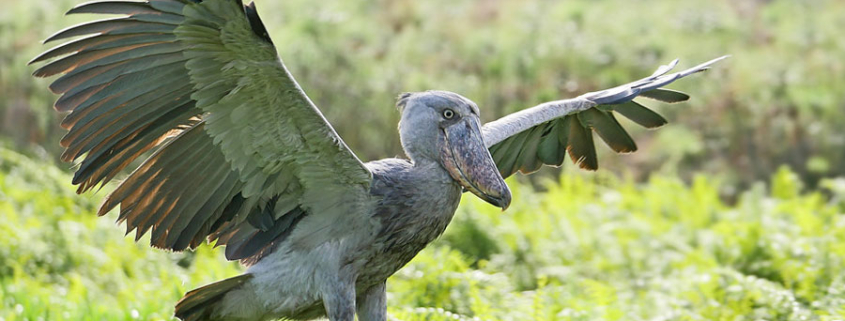Shoebill Stork Size and Facts
Shoebill Stork Size and Facts : Shoebill stork is the prehistorical bird specie that is also known as the whale head and among others. The shoebill stork gets its title from its huge shoe-shaped bill. Shoebill has got the shape of the bill and it was originally placed in the other ciconiiformes with the storks that is based on the morphology. The shoebill stork is the attractive bird specie on a Uganda safari. The bill of the stork is such unique as it helps it to catch the prey like tilapia, snakes, lungfish, new born crocodiles, lizards and among others where it feeds on.
Shoebill stork size and facts.
Shoebill stork’s size is characterized by its body structure, eating habits life span, habitants, and behaviors and among others.
Shoebill stork is huge compared to other bird species.
Shoebill stork’s has got the yellow eyes, grey feathers, tiny feathered crest on the back of their heads, white bellies, the bird specie can even grow tall with eight foot wingspan. The shoebill stork has got the slender legs with the big feet that helps the shoebill stork to walks gently to the vegetation on the fresh water marshes, swamps of all the African countries like Kenya, Rwanda, South Sudan, Tanzania, and Ethiopia and among others.
Physical characterizes of the shoebill stork.
Mouth. The shoebill stork has got the shoe shaped mouth that’s where the name originates from and also the strong bent beak as this allows the shoe bill to cut the fresh and its food into the manageable pieces that it can easily consume with in the shortest period of time.
Foot. The shoebill stork has a length foot that can measure up to 18 cm that even can be compared to the size of the human beings foot.
Weight. The mature female shoebill stork weighs approximately 11 pounds also equal to 5.6 kilograms whereas the male shoebill stork can weigh about 12 pounds or 4.9 kilograms.
Height. The adult shoebill stork can even reach at the height of about 4 to 5 feet while standing on its two legs that makes it to be known as the tallest bird specie on a Uganda birding safari that impresses the tourists.
Habitats of the shoebill stork.
Shoebill stork is known as the acquatic and the nocturnal bird specie that spends its life near the water bodies, the shoebill stork prefers the areas with water, dense marshes and helps them to easily catch their food from their habitats. Due to the fact that the environment easily makes the shoebill stork to sustain their lives, that’s the reason to why the shoebill storks are highly found in Uganda, as these are commonly spotted during the different safari activities like bird watching, nature walks, game drives, boat cruises and among others.

Shoebill Stork Size and Facts
On a Uganda safari the shoebill stork can be spotted in the different safari destinations including Mabamba swamp, near Lake Victoria, Ziwa rhino sanctuary, Lake Mburo national park, Queen Elizabeth national park, Semuliki wildlife reserve, and Nabajuzi swamp in Masaka the list is endless. On a Uganda safari, the country is a birder’s paradise with the different and beautiful bird species that are found nowhere else in the world.
Not only in Uganda the shoebill stork can be found in other destinations like Rwanda, Tanzania, Sudan, Zambia, Congo, Botswana and among many others, because the destinations have got enough food for the shoebill stork, and there are places where the shoebill stork easily hides from its predators hence sustaining its lives, with breeding places where they easily make their nests.
Reproductive cycle of the shoebill stork.
The adulthood in the shoebill storks is 3 to 4 years as the breeding couples are monogamous, not only the shoebill stork being the solitary bird specie, as they only meet when going to conceive, and the period when the breeding pairs are going to construct the nests that can be near water place, and females deposit an average of two eggs.
Both the bird species care for the eggs as the young co-parents. Incubating and flipping eggs, and hatching takes a period of one month, then chicks can be covered in bluish gray own and have a lighter cored beak, as one chick survives to fledge.
Relationship between the shoebill stork and a human being.
Bird lovers consider the shoebill stork as the most attractive and the top most loved bird species in Africa, as they are gentle with humans and does not have any threatening behavior, and can easily be seen and studied by researchers.
Shoebill stork’s diet.
Shoebill stork relies on the water mammals and has got a large number of preys including the fish species like cat fish, lung fish, eels, baby crocodiles, reptiles, water snakes, frogs and among many others that fits in its mouth. That’s the reason to why they prefer inhabiting the water logged areas where they use their unique technology to catch the food.
Conservation status of the shoebill stork.
Shoebill stork used to have the large numbers whereby they could range from 5000 to 8000 whereas Africa is occupied by the wetlands in the countries where the shoebill stork is found like Uganda, Sudan, Congo, Rwanda, Zambia, and Tanzania and among others. There is viable population in Tanzania’s Malagarasi wetlands, it’s categorized as the vulnerable by Birdlife International, with the primary risks being habitat loss, hunting, and disturbance by selling them in the zoos where they get a lot of money and among others.
Shoebill stork is among the endangered bird specie according to the convention on international trade in endangered species of Wild Fauna and Flora lists the bird.







Leave a Reply
Want to join the discussion?Feel free to contribute!